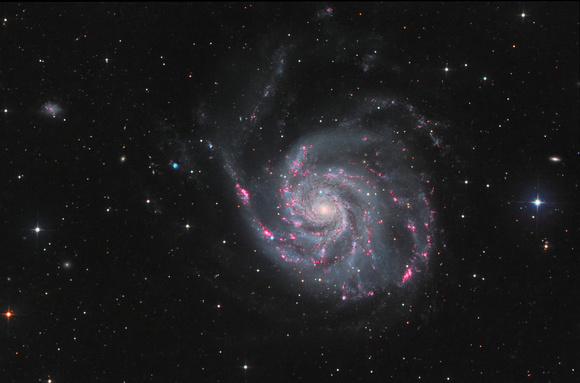M101 & SN 2023ixf - 1 day post Type II Supernova
M101 & SN 2023ixf in LHaRGB (Ursa Major) , May 20th 2023
Planewave CDK12.5" telecope and A-P 1100GTO AE mount
ASI6200MM Camera, Antlia Pro BB & 3nm Ha Filters
Lum (20 x 200s exposures, Bin 2x2, Gain 100)
RGB (3 x 20 x 240s exposures, Bin 2x2 Gain 100)
Ha (23 x 400s exposures, Bin 2x2, Gain200, from previous image)
Incremental Integration Time = 5.1 hours
On May 20th, I learned that a Type II supernova had detonated in M101 and due to a bit of luck, images had been captured the night before by the Plaskett telescope being used by the RASC Observers group.
Since I had recently imaged M101 just a few days before, and the skies were forecast to be reasonably clear, I thought I would take some more frames to make a before/after comparison.
The result of this exercise is shown here, aligned and framed exactly the same as my May 13-16th image. The supernova is visible at 8 o'clock on the galaxy as a blue star, just below a prominant red star forming region on the galaxie's outer arm. This is quite a feat, given that every other star resolved in the image is actually a foreground star within the Milky Way.
Supernova are giant blasts of all flavours of elements that takes place when a giant star exhausts its fuel and implodes into the core. The rapid compression of material as it rushes to the core heats up the star (Joule-Thompson heating on steroids?) , new endothermic fusion reactions take place, and the implosion becomes an explosion - all in a few seconds.
Still trying to obtain a photometric measurement of the SN numerically, and will repost if I am successful.
The supernova may brighten over the next few days, but will fade again over the following few weeks. I will be monitoring to see if more imaging is warranted - as I read up on Type II supernova.
In processing the new image, I had various options such as just pasting the supernova star on to the old image, or removing first all the stars and putting new stars, including the supernova, back in. What I decided to do was to treat the supernova image as completely new using new data (except for Ha) and aligning it to the old image. Besides, by this time I had collimated my CDK.


